2005 AUDI A6 engine
[x] Cancel search: enginePage 57 of 92
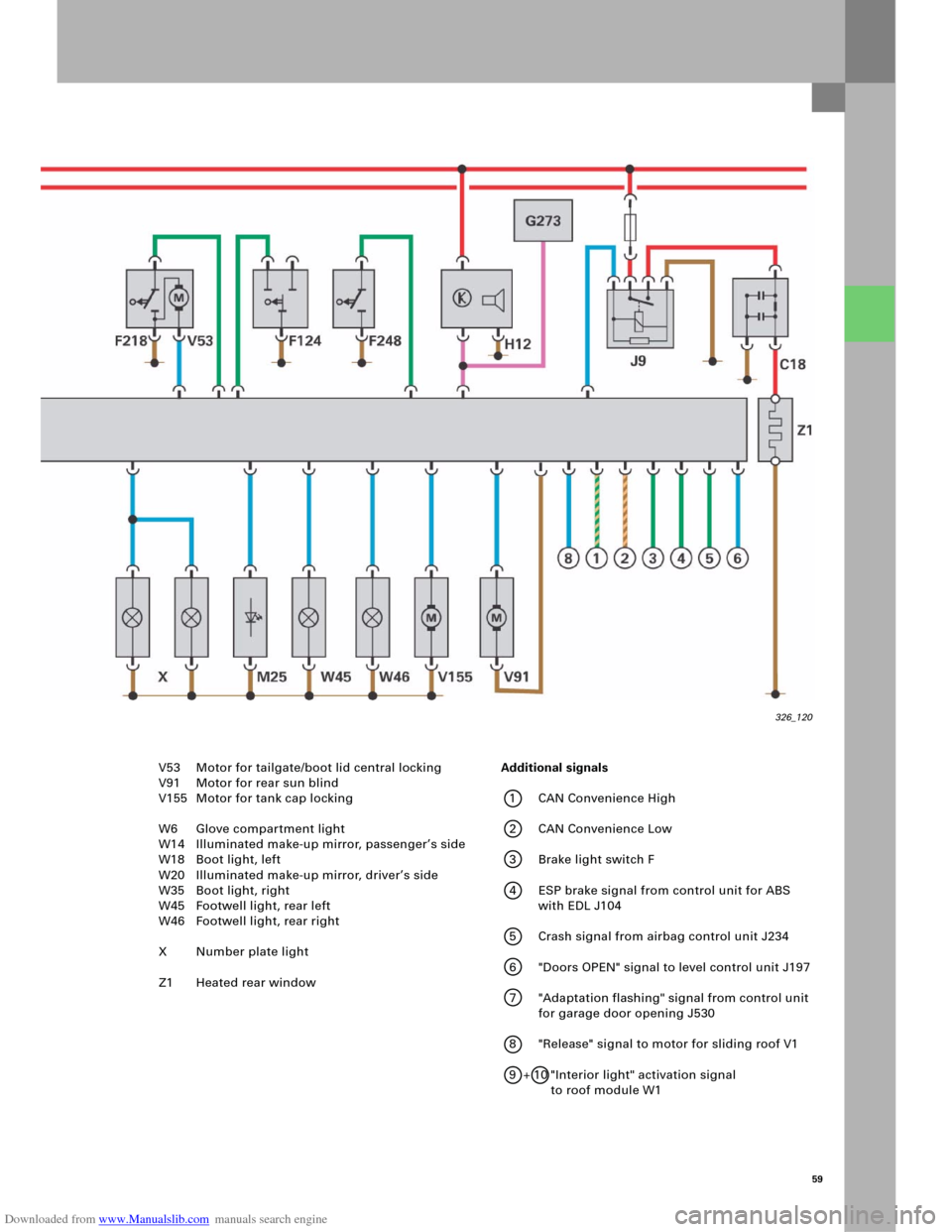
Downloaded from www.Manualslib.com manuals search engine 59
326_120
V53 Motor for tailgate/boot lid central locking
V91 Motor for rear sun blind
V155 Motor for tank cap locking
W6 Glove compartment light
W14 Illuminated make-up mirror, passenger’s side
W18 Boot light, left
W20 Illuminated make-up mirror, driver’s side
W35 Boot light, right
W45 Footwell light, rear left
W46 Footwell light, rear right
X Number plate light
Z1 Heated rear window Additional signals
1CAN Convenience High
2CAN Convenience Low
3 Brake light switch F
4 ESP brake signal from control unit for ABS
with EDL J104
5 Crash signal from airbag control unit J234
6 "Doors OPEN" signal to level control unit J197
7 "Adaptation flashing" signal from control unit
for garage door opening J530
8 "Release" signal to motor for sliding roof V1
9 + 10 "Interior light" activation signal
to roof module W1
Page 58 of 92
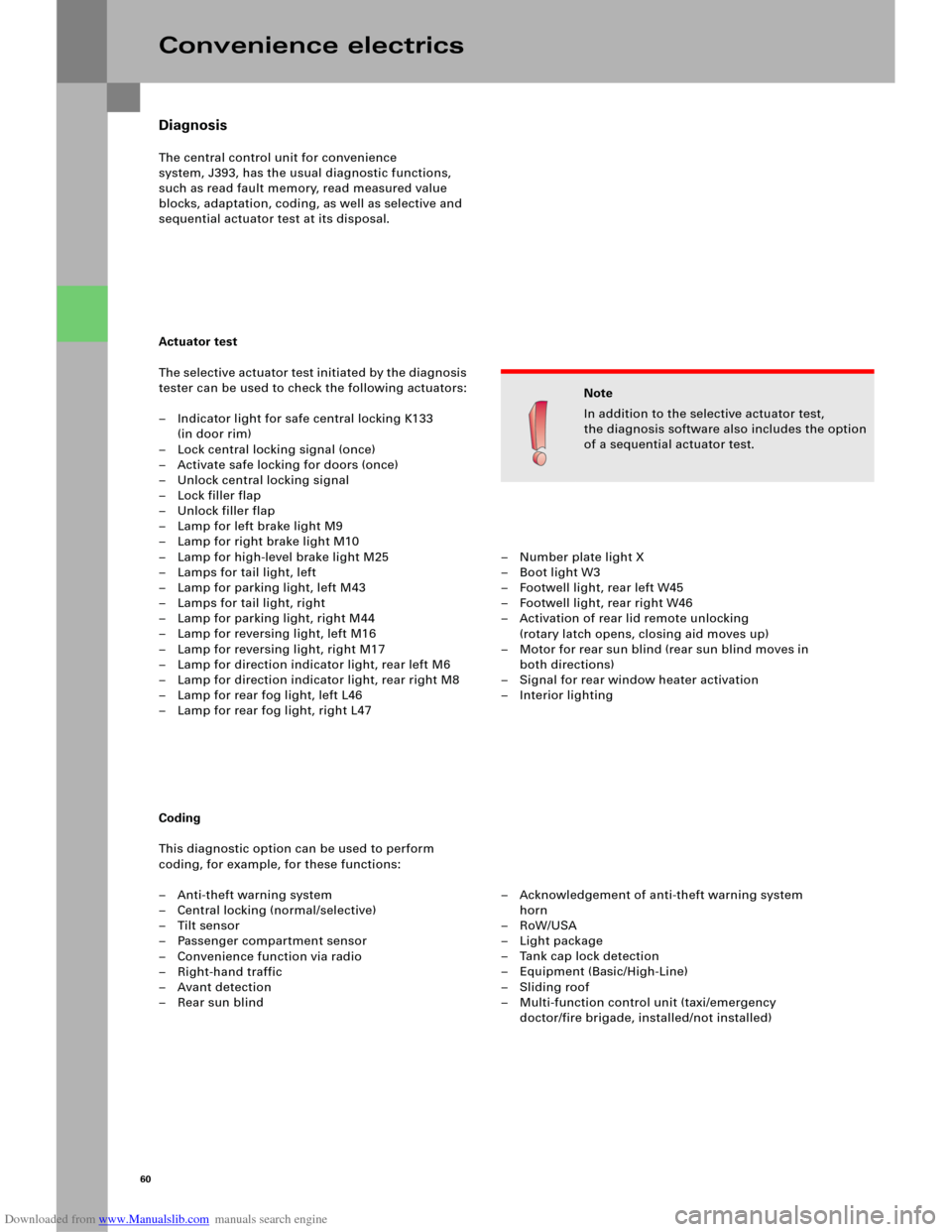
Downloaded from www.Manualslib.com manuals search engine 60
Diagnosis
The central control unit for convenience
system, J393, has the usual diagnostic functions,
such as read fault memory, read measured value
blocks, adaptation, coding, as well as selective and
sequential actuator test at its disposal.
Actuator test
The selective actuator test initiated by the diagnosis
tester can be used to check the following actuators:
– Indicator light for safe central locking K133
(in door rim)
– Lock central locking signal (once)
– Activate safe locking for doors (once)
– Unlock central locking signal
– Lock filler flap
– Unlock filler flap
– Lamp for left brake light M9
– Lamp for right brake light M10
– Lamp for high-level brake light M25
– Lamps for tail light, left
– Lamp for parking light, left M43
– Lamps for tail light, right
– Lamp for parking light, right M44
– Lamp for reversing light, left M16
– Lamp for reversing light, right M17
– Lamp for direction indicator light, rear left M6
– Lamp for direction indicator light, rear right M8
– Lamp for rear fog light, left L46
– Lamp for rear fog light, right L47
Coding
This diagnostic option can be used to perform
coding, for example, for these functions:
– Anti-theft warning system
– Central locking (normal/selective)
–Tilt sensor
– Passenger compartment sensor
– Convenience function via radio
–Right-hand traffic
–Avant detection
–Rear sun blind
Convenience electrics
Note
In addition to the selective actuator test,
the diagnosis software also includes the option
of a sequential actuator test.
– Number plate light X
– Boot light W3
– Footwell light, rear left W45
– Footwell light, rear right W46
– Activation of rear lid remote unlocking
(rotary latch opens, closing aid moves up)
– Motor for rear sun blind (rear sun blind moves in
both directions)
– Signal for rear window heater activation
–Interior lighting
– Acknowledgement of anti-theft warning system
horn
–RoW/USA
–Light package
– Tank cap lock detection
– Equipment (Basic/High-Line)
–Sliding roof
– Multi-function control unit (taxi/emergency
doctor/fire brigade, installed/not installed)
Page 59 of 92
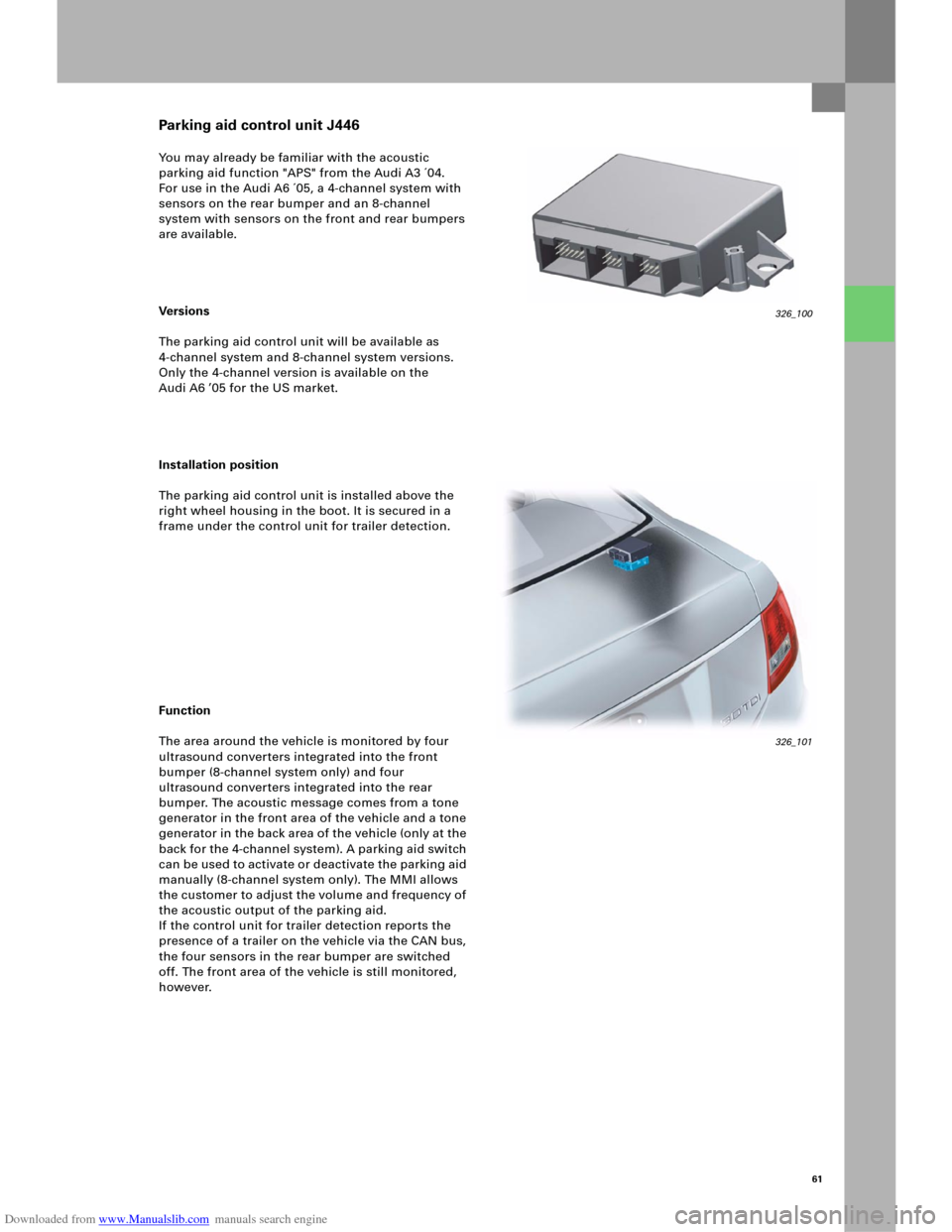
Downloaded from www.Manualslib.com manuals search engine 61
You may already be familiar with the acoustic
parking aid function "APS" from the Audi A3 ´04.
For use in the Audi A6 ´05, a 4-channel system with
sensors on the rear bumper and an 8-channel
system with sensors on the front and rear bumpers
are available.
Ve rs i on s
The parking aid control unit will be available as
4-channel system and 8-channel system versions.
Only the 4-channel version is available on the
Audi A6 ’05 for the US market.
Installation position
The parking aid control unit is installed above the
right wheel housing in the boot. It is secured in a
frame under the control unit for trailer detection.
Function
The area around the vehicle is monitored by four
ultrasound converters integrated into the front
bumper (8-channel system only) and four
ultrasound converters integrated into the rear
bumper. The acoustic message comes from a tone
generator in the front area of the vehicle and a tone
generator in the back area of the vehicle (only at the
back for the 4-channel system). A parking aid switch
can be used to activate or deactivate the parking aid
manually (8-channel system only). The MMI allows
the customer to adjust the volume and frequency of
the acoustic output of the parking aid.
If the control unit for trailer detection reports the
presence of a trailer on the vehicle via the CAN bus,
the four sensors in the rear bumper are switched
off. The front area of the vehicle is still monitored,
however.
326_100
Parking aid control unit J446
326_101
Page 60 of 92
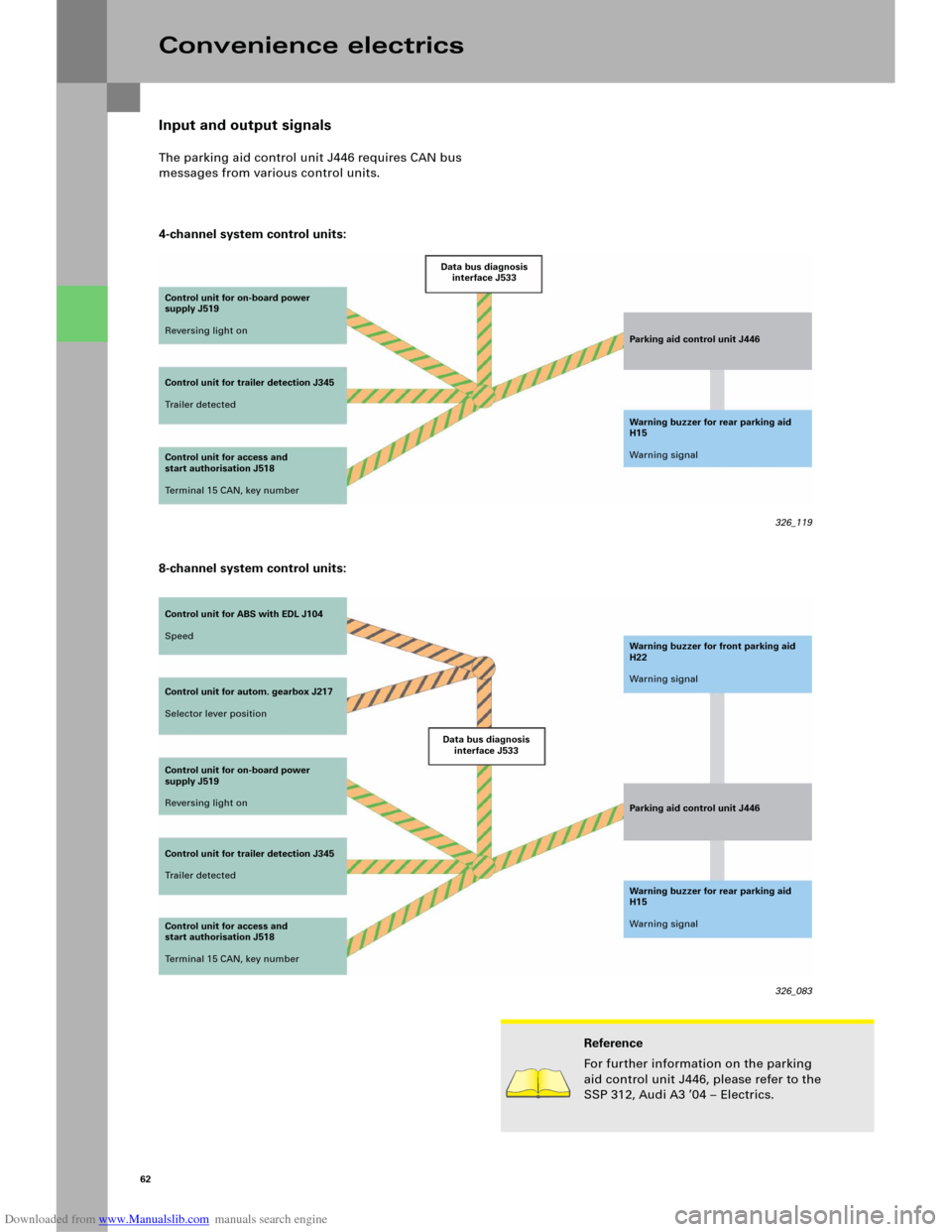
Downloaded from www.Manualslib.com manuals search engine 62
326_119
Input and output signals
The parking aid control unit J446 requires CAN bus
messages from various control units.
4-channel system control units:
Convenience electrics
Control unit for on-board power
supply J519
Reversing light on
Control unit for trailer detection J345
Tr a i l e r d e t e c t e dData bus diagnosis
interface J533
Parking aid control unit J446
Warning buzzer for rear parking aid
H15
Warning signal
Control unit for access and
start authorisation J518
Terminal 15 CAN, key number
Control unit for ABS with EDL J104
Speed
Control unit for autom. gearbox J217
Selector lever position
Control unit for on-board power
supply J519
Reversing light on
Control unit for trailer detection J345
Tr a i l e r d e t e c t e dData bus diagnosis
interface J533Warning buzzer for front parking aid
H22
Warning signal
Parking aid control unit J446
Warning buzzer for rear parking aid
H15
Warning signal
326_083 Control unit for access and
start authorisation J518
Terminal 15 CAN, key number
Reference
For further information on the parking
aid control unit J446, please refer to the
SSP 312, Audi A3 ’04 – Electrics.
8-channel system control units:
Page 61 of 92
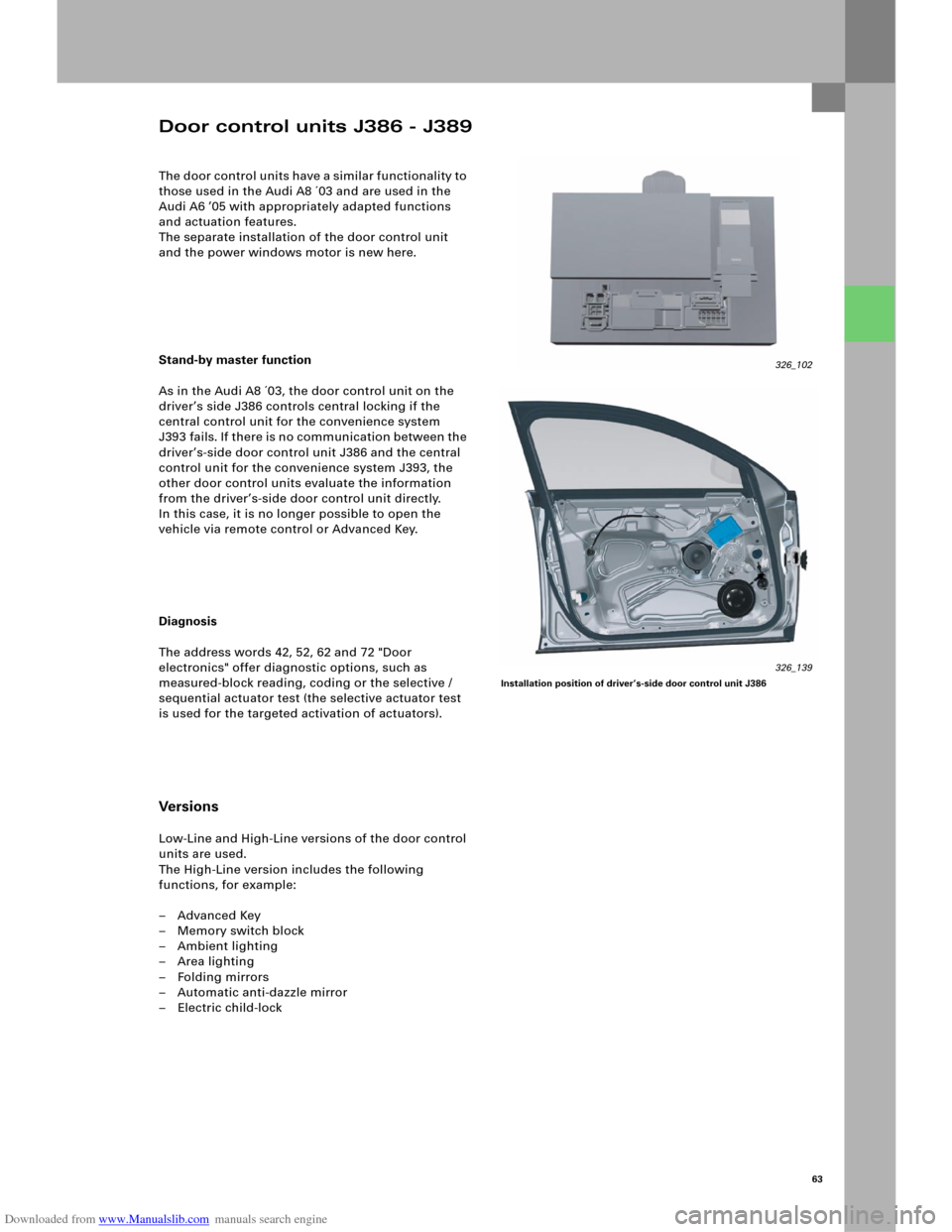
Downloaded from www.Manualslib.com manuals search engine 63
The door control units have a similar functionality to
those used in the Audi A8 ´03 and are used in the
Audi A6 ’05 with appropriately adapted functions
and actuation features.
The separate installation of the door control unit
and the power windows motor is new here.
Stand-by master function
As in the Audi A8 ´03, the door control unit on the
driver’s side J386 controls central locking if the
central control unit for the convenience system
J393 fails. If there is no co mmunic atio n b etw een the
driver’s-side door control unit J386 and the central
control unit for the convenience system J393, the
other door control units evaluate the information
from the driver’s-side door control unit directly.
In this case, it is no longer possible to open the
vehicle via remote control or Advanced Key.
Diagnosis
The address words 42, 52, 62 and 72 "Door
electronics" offer diagnostic options, such as
measured-block reading, coding or the selective /
sequential actuator test (the selective actuator test
is used for the targeted activation of actuators).
Versi on s
Low-Line and High-Line versions of the door control
units are used.
The High-Line version includes the following
functions, for example:
– Advanced Key
– Memory switch block
– Ambient lighting
–Area lighting
–Folding mirrors
– Automatic anti-dazzle mirror
– Electric child-lock
Installation position of driver’s-side door control unit J386326_139
Door control units J386 - J389
326_102
Page 62 of 92
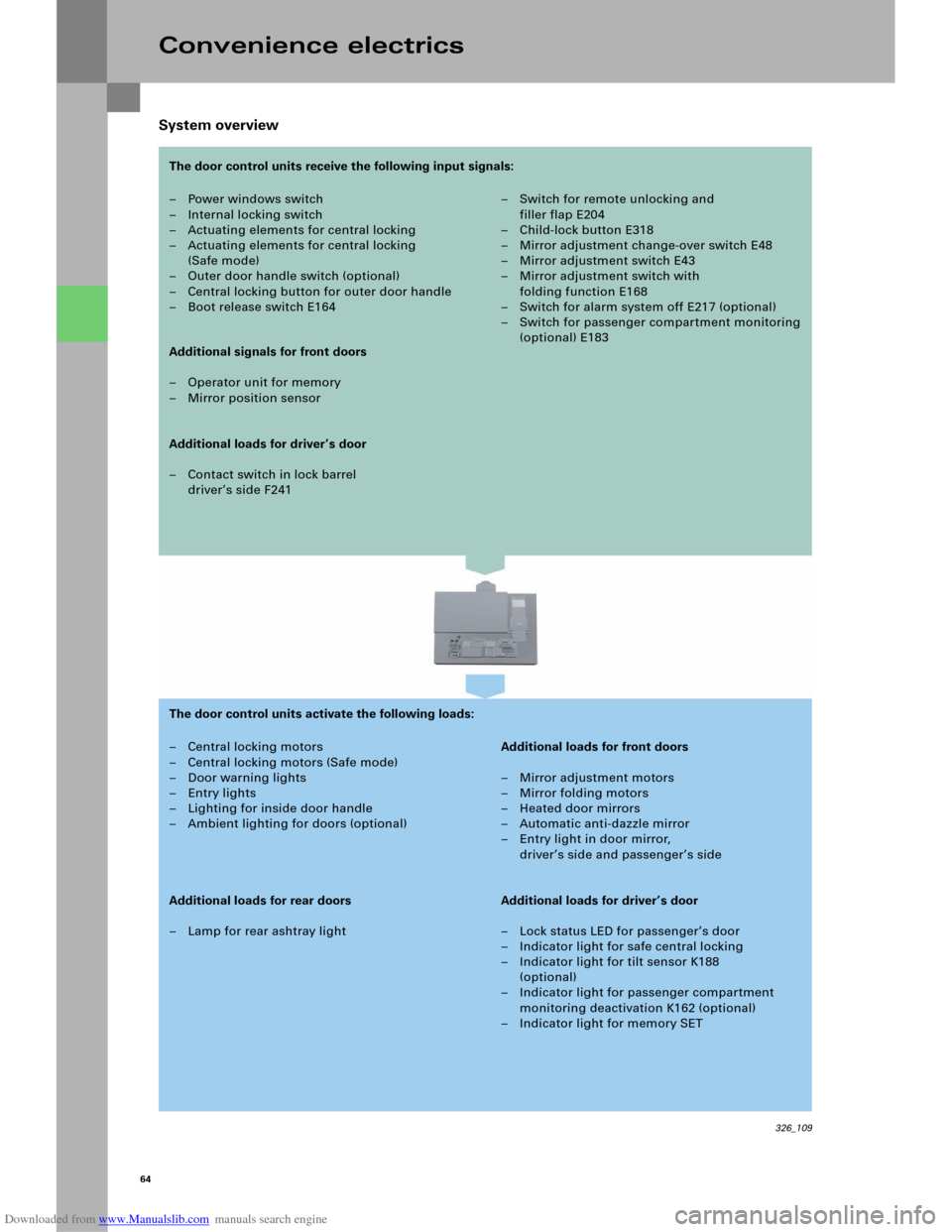
Downloaded from www.Manualslib.com manuals search engine 64
System overview
Convenience electrics
– Power windows switch
– Internal locking switch
– Actuating elements for central locking
– Actuating elements for central locking
(Safe mode)
– Outer door handle switch (optional)
– Central locking button for outer door handle
– Boot release switch E164– Switch for remote unlocking and
filler flap E204
–Child-lock button E318
– Mirror adjustment change-over switch E48
–Mirror adjustment switch E43
– Mirror adjustment switch with
folding function E168
– Switch for alarm system off E217 (optional)
– Switch for passenger compartment monitoring
(optional) E183
Additional signals for front doors
– Operator unit for memory
– Mirror position sensor
Additional loads for driver’s door
– Contact switch in lock barrel
driver’s side F241
– Central locking motors
– Central locking motors (Safe mode)
– Door warning lights
–Entry lights
– Lighting for inside door handle
– Ambient lighting for doors (optional)Additional loads for front doors
– Mirror adjustment motors
– Mirror folding motors
– Heated door mirrors
– Automatic anti-dazzle mirror
– Entry light in door mirror,
driver’s side and passenger’s side
Additional loads for rear doors
–Lamp for rear ashtray lightAdditional loads for driver’s door
– Lock status LED for passenger’s door
– Indicator light for safe central locking
– Indicator light for tilt sensor K188
(optional)
– Indicator light for passenger compartment
monitoring deactivation K162 (optional)
– Indicator light for memory SET
326_109
The door control units receive the following input signals:
The door control units activate the following loads:
Page 63 of 92
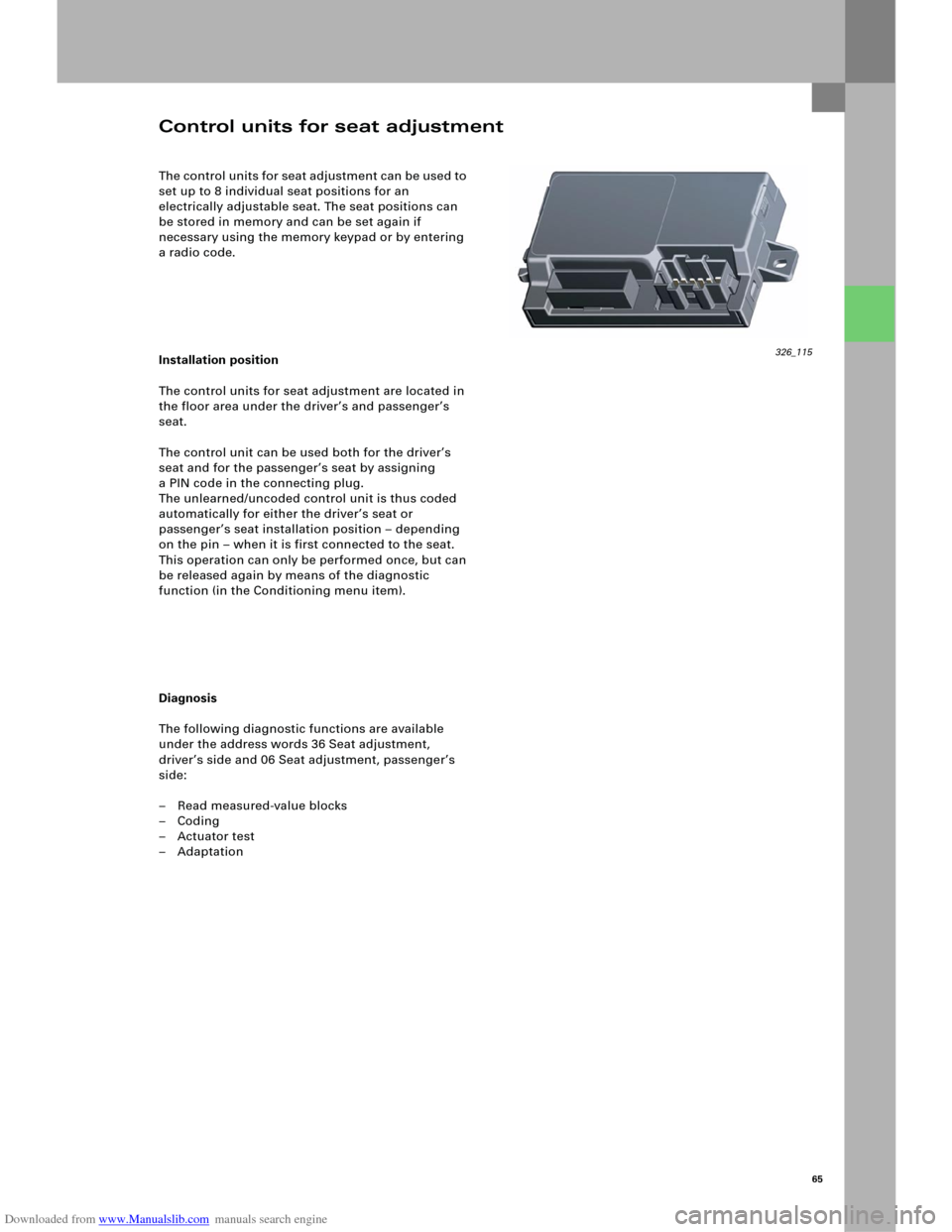
Downloaded from www.Manualslib.com manuals search engine 65
The control units for seat adjustment can be used to
set up to 8 individual seat positions for an
electrically adjustable seat. The seat positions can
be stored in memory and can be set again if
necessary using the memory keypad or by entering
a radio code.
Installation position
The control units for seat adjustment are located in
the floor area under the driver’s and passenger’s
seat.
The control unit can be used both for the driver’s
seat and for the passenger’s seat by assigning
a PIN code in the connecting plug.
The unlearned/uncoded control unit is thus coded
automatically for either the driver’s seat or
passenger’s seat installation position – depending
on the pin – when it is first connected to the seat.
This operation can only be performed once, but can
be released again by means of the diagnostic
function (in the Conditioning menu item).
Diagnosis
The following diagnostic functions are available
under the address words 36 Seat adjustment,
driver’s side and 06 Seat adjustment, passenger’s
side:
– Read measured-value blocks
–Coding
–Actuator test
–Adaptation
Control units for seat adjustment
326_115
Page 64 of 92
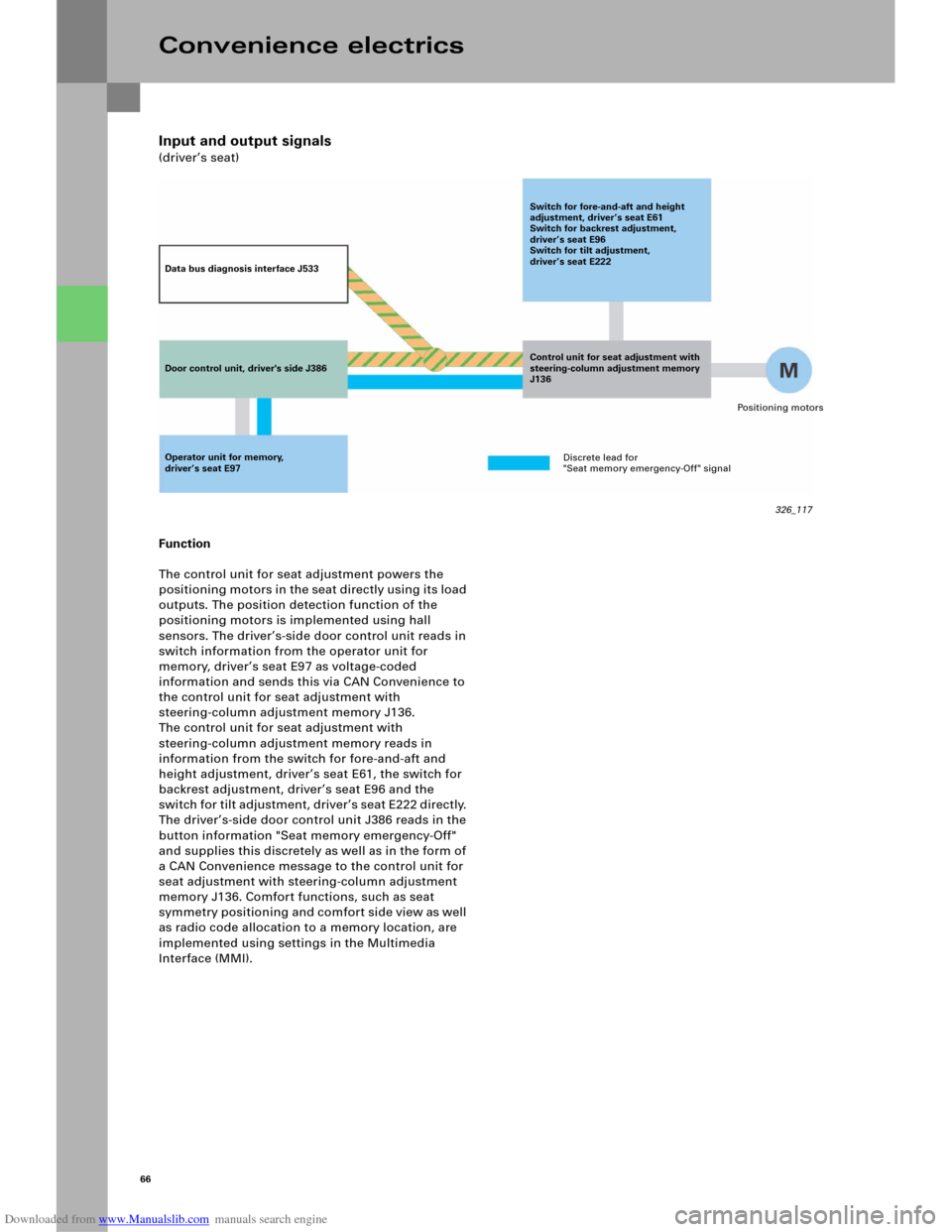
Downloaded from www.Manualslib.com manuals search engine 66
Input and output signals
(driver’s seat)
Convenience electrics
Function
The control unit for seat adjustment powers the
positioning motors in the seat directly using its load
outputs. The position detection function of the
positioning motors is implemented using hall
sensors. The driver’s-side door control unit reads in
switch information from the operator unit for
memory, driver’s seat E97 as voltage-coded
information and sends this via CAN Convenience to
the control unit for seat adjustment with
steering-column adjustment memory J136.
The control unit for seat adjustment with
steering-column adjustment memory reads in
information from the switch for fore-and-aft and
height adjustment, driver’s seat E61, the switch for
backrest adjustment, driver’s seat E96 and the
switch for tilt adjustment, driver’s seat E222 directly.
The driver’s-side door control unit J386 reads in the
button information "Seat memory emergency-Off"
and supplies this discretely as well as in the form of
a CAN Convenience message to the control unit for
seat adjustment with steering-column adjustment
memory J136. Comfort functions, such as seat
symmetry positioning and comfort side view as well
as radio code allocation to a memory location, are
implemented using settings in the Multimedia
Interface (MMI).
Data bus diagnosis interface J533
Door control unit, driver's side J386Switch for fore-and-aft and height
adjustment, driver’s seat E61
Switch for backrest adjustment,
driver’s seat E96
Switch for tilt adjustment,
driver’s seat E222
Control unit for seat adjustment with
steering-column adjustment memory
J136
Operator unit for memory,
driver’s seat E97Discrete lead for
"Seat memory emergency-Off" signalPositioning motors
326_117